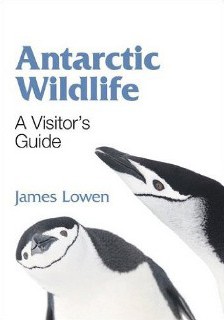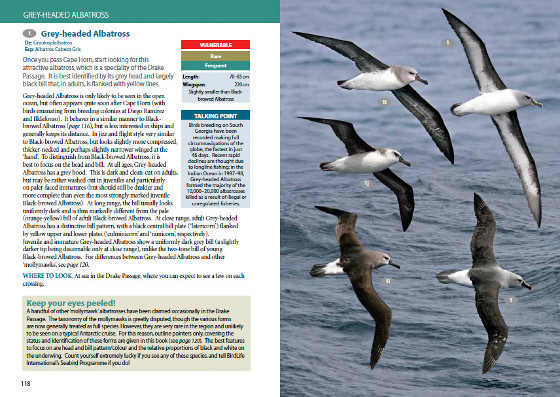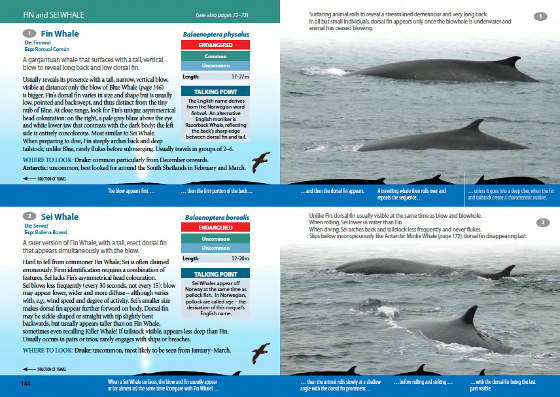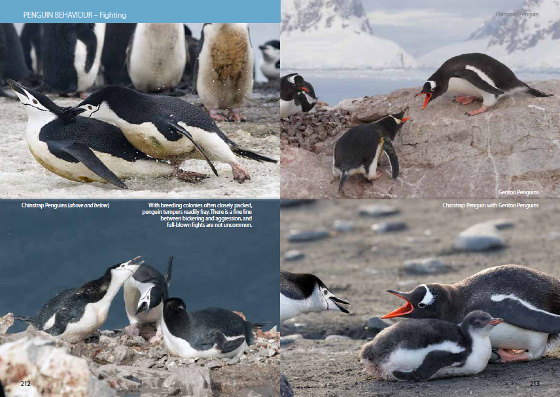Reviewed by Grant McCreary on October 23rd, 2011.
If you could travel anywhere, where would you go? My shortlist of answers to this question isn’t all that short and constantly changes. But Antarctica is always on it. Antarctica? It is cold (I hate cold) and doesn’t have all that many birds (I want to see lots of birds). But what it lacks in quantity it more than makes up in quality (penguins – ‘nuff said). So it was with great excitement, and not a little trepidation, that I received Antarctic Wildlife: A Visitor’s Guide, by James Lowen.
Antarctic Wildlife is one of the most unique field guides I’ve come across. It’s not just the photographs, layout, or any one particular thing. Rather, it is the overall approach taken by the author. Lowen intended this to be a guide to the wildlife – marine mammals, birds, and a few plants – one might see on a typical cruise from Argentina or Chile to the Antarctic Peninsula. Everything about the book serves this purpose in an extremely user-friendly manner.
This starts with the extensive introduction. In addition to the standard descriptions of the book and how to use it, the author has included an overview of the environments you will pass through, the Antarctic cruise experience, and the wildlife. Actually, it is much more than a mere overview, especially regarding the wildlife. Lowen introduces each of the families included, from seals to skuas (and one page on plants), gives identification tips, and tells where to look for these animals during the different segments of your cruise. There are even tables listing the species you are likely to see in different parts of the Antarctic Peninsula, so that you can better prepare based on your particular ship’s itinerary. This introductory material is excellent; the author seems to have included everything you might need in order to make the best of your trip.
Antarctic Wildlife limits its geographic scope to just the areas routinely traversed by Antarctic cruises. The species accounts are even divided based on the cruise’s three distinct sectors: the Beagle Channel; the Drake Passage; and the Antarctic Peninsula. Normally, I despise such “gimmicky” organizations in field guides. But it works here, for the most part, mainly due to the relatively small number of species covered. Species are only included in one section, even if they are possible in others. But if you don’t find a likely match for a creature seen in one, it’s quick and easy to look through the other two as well. But attempting the same organization for almost anywhere else – say, a trip down the Manu – would be utterly insane. However, this scheme does make it more difficult to directly compare related species.
Species Accounts
The accounts follow the standard plan, with photographic plates on the right-hand page and text on the left. One to five species are included on any given two-page spread, though most have just one or two. Each account includes:
- Name – English, Scientific, German, and Spanish
- Threat Status – according to the International Union for Conservation of Nature
- Status – color-coded bars giving abundance in each of the three sectors
- Measurements – length and wingspan in centimeters; comparison to other species, as appropriate
- Talking Point – interesting tidbits
- Main text – description and identification tips
- Where to Look – where exactly to look in each sector
The few number of species per page means that the text is pretty extensive – and often very interesting. I particularly enjoy the “talking points” and various sidebars scattered throughout the guide. The whale accounts also include a helpful diagram showing what it looks like when surfacing.
The plates of most mammals and some birds are partitioned traditionally. However, those for most birds feature photographs edited onto a common background, similar in style to The Crossley ID Guide, although not nearly as complex as Crossley’s scenes. Each image is labeled with a number and, when applicable, a code denoting sex, age, and breeding/non-breeding. The photos are good to great, and the plates very attractive overall. The relatively few number of species per plate accords the space to include multiple images of each bird. The variation depicted should be sufficient to identify most birds. Some seabirds, however, are extremely difficult to identify. I would recommend serious birders also carry along a more detailed guide for them.
The cetacean accounts only include photos of the animal at the surface. This makes sense, as that is all that you are going to see in the field. However, if you’d like to see what the animal as a whole looks like, there is a wonderful two-page plate in the introduction that illustrates these whales and dolphins “in all their unconcealed glory”. Thoughtful inclusions like this really set this guide apart.
Another nice touch is that some species, such as Wandering Albatross, and Humpback and Killer Whales, have supplementary pages of photographs in order to show a greater variety of appearance and behaviors. There are also an additional 22 pages of incredible (and useful) photographs of penguin behavior.
One final nice thing about this guide is that a portion of the proceeds will go to support the Save the Albatross campaign.
Recommendation
Earlier in this review I mentioned receiving this book with a measure of trepidation. This was not borne out of any misgivings about the book’s quality, but rather its anticipated effect on me. I was right to be wary; thanks to this book, I now want to go to Antarctica more than ever! And if (hopefully, when) I go, it will not be without this book. Antarctic Wildlife: A Visitor’s Guide should be required for any cruise-based visitor to the great white continent. And if you want to risk being compelled to pay big bucks to go on such a cruise, I’d also recommend it to anyone even slightly interested in the wildlife of Antarctica.
For those traveling to Antarctica outside of the area covered by this book, as well as serious birders and those wanting to know even more about the wildlife they may encounter, I would also recommend the more extensive (and larger and heavier) The Complete Guide to Antarctic Wildlife, by Hadoram Shirihai.
Disclosure: I get a small commission for purchases made through links in this post.
Disclosure: The item reviewed here was a complementary review copy provided by the publisher. But the opinion expressed here is my own, it has not been influenced in any way.








Does this guide book by chance go into identification of the different killer whale morphs?
@Morgan: Yes, it does. The text describes all three types and where they are usually found. The plate includes a photo of each taken from just about identical angles. All 3 are also shown on the cetacean comparison plate.